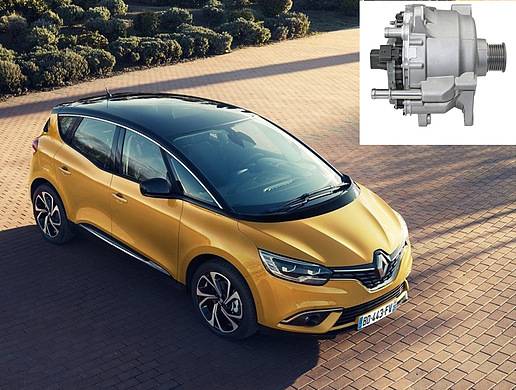 据了解,大陆的48V系统将作为一种标配,同时登陆汽油和柴油版雷诺风景混合动力MPV(Scenic Hybrid Assist)。ISG单元位于内燃发动机前端辅机驱动的所谓的“P0 [零]”位置,其中包括一款5kW·h的锂离子电池。
据了解,大陆的48V系统将作为一种标配,同时登陆汽油和柴油版雷诺风景混合动力MPV(Scenic Hybrid Assist)。ISG单元位于内燃发动机前端辅机驱动的所谓的“P0 [零]”位置,其中包括一款5kW·h的锂离子电池。 大陆集团北美混合动力工程主管Juergen Wiesenberger表示,该系统可在0.2秒内启动车辆内燃机,几乎比12V启停系统快一倍,而且还能协助柴油车型将尾气中的NOx排放降低最高10%。
大陆集团北美混合动力工程主管Juergen Wiesenberger表示,该系统可在0.2秒内启动车辆内燃机,几乎比12V启停系统快一倍,而且还能协助柴油车型将尾气中的NOx排放降低最高10%。 大陆集团混动业务执行副总裁Rudolf Stark认为,48V系统将成为混合电动和纯电动汽车之间的“过渡技术”。
大陆集团混动业务执行副总裁Rudolf Stark认为,48V系统将成为混合电动和纯电动汽车之间的“过渡技术”。
如今,汽车行业已经开始争先采用48V混动系统。近日,雷诺(Renault)宣布,将于下月进入量产的全新2017款风景(Scenic)MPV将采用大陆(Continental)公司的低压“轻”混合技术。在此之前,奥迪(Audi)也曾宣布旗下2017款SQ7将采用法雷奥(Valeo)的48V系统。此外,梅赛德斯-奔驰(Mercedes-Benz)也在近日宣布,新型六缸和四缸直列发动机系列也将采用48V子系统。
据了解,大陆的48V系统将作为一种标配,同时登陆汽油和柴油版的雷诺风景混合动力多功能车(Scenic Hybrid Assist)。该系统直接将液冷电机和逆变器集成至电机壳体之内,共同组成启动器发电机(ISG)。系统具体位于内燃发动机前端辅机驱动的一般称为“P0”的位置,通过筋带与曲轴连接。大陆北美公司混合电动车工程主管Juergen Wiesenberger表示,系统内含一个5 kW·h的锂离子电池,电池重约15kg(33lb)。
Wiesenberger告诉《汽车工程》杂志,登陆雷诺对大陆集团庞大的48V计划来说,只是冰山一角。大陆集团计划在未来几年内向北美、欧洲和中国市场大量输送48V系统,同时登陆汽油和柴油车型。大陆集团混合电动业务部执行副总裁Rudolf Stark称,预计到2020年,全球采用48V系统的车辆总数将达到400万辆;到2025年,全球约有20%的新车均将配备48V系统。
Stark认为,48V系统将成为混合电动和纯电动汽车之间的“过渡技术”,为车辆提供额外6到20kW的功率,从而满足不断提升的汽车能效需求,并为客户提供一系列新功能,包括电加热挡风窗、自适应悬架系统及电动涡轮增压器等。比较来看,全混合动力系统的功率输出通常在20-40kW,插电式混合动力系统一般则在50-90kW。
Stark也认同其他推进系统工程师的看法,称48V系统能够“以30%的成本,提供其他高功率系统70%的效益。”Stark和Wiesenberger均表示,在同级别车内,与其他非混合动力系统相比,大陆的最新48V量产系统已经在真实驾驶环境下表现出了超过20%的燃料经济性提升。
除了大陆集团,目前多家一级供应商均在积极敲定ISG和P2型(位于内燃机与变速器之间“P2”位置的电机)系统的生产合同。2017到2020年间,随着世界各主要地区CO2减排规定越来越严格,这些系统预计也将逐步上市。
Wiesenberger表示,根据具体规格不同,大陆的液冷48V ISG系统大约可连续输出6 kW的功率和60 N·m的扭矩,安装体积与12V启动器交流发电机相仿。根据版本不同,ISG系统最高可输出150 N·m的扭矩。另外,这款48V系统应用了模块化设计理念,采用了MOSFET型逆变器。
Wiesenberger表示,该系统可在0.2秒内启动车辆内燃机,几乎比12V启停系统快一倍。他补充说,当配合柴油发动机使用时,由于电机可提供额外的扭矩,48V系统在较低转速时可以将尾气中的NOx排放降低10%。
P2型48V系统可以独立于内燃机运行。Wiesenberger表示,大陆与舍弗勒(Schaeffler)联合开发的P2型48V系统可为车辆提供50km/h的最高车速。与其他非混动型号相比,节油表现更是高达25%。
The industry’s race to deploy 48-V hybrid systems has begun. Renault is the latest OEM to announce incorporation of the “mild” low-voltage hybrid technology, developed and supplied by Continental, in its new 2017 Scenic MPV entering production next month. The news follows Audi’s earlier production announcement of a Valeo-supplied 48-V system in the 2017 SQ7 (http://articles.sae.org/14662 ). Mercedes also recently announced its new inline-six and four-cylinder engine families will include 48-V subsystems.
Conti’s 48-V system will be standard equipment on both gasoline and diesel versions of the Scenic Hybrid Assist model. The system features a liquid-cooled induction motor with inverter integrated into the motor housing comprising the integrated starter-generator (ISG) unit. It is fitted in the so-called “P0 [zero]” position on the combustion engine’s front-end accessory drive, coupled to the crankshaft via a reinforced belt. The system includes a .5 kW·h lithium-ion battery. Total system mass including battery is 15 kg (33 lb), said Juergen Wiesenberger, head of HEV engineering at Continental North America.
The Renault business is the tip of the iceberg for Continental’s 48-V program, Wiesenberger told Automotive Engineering. The company has 48-V production programs in the pipeline for both gasoline and diesel vehicles in North America, Europe and China over the next few years. His colleague Rudolf Stark, executive VP of Conti’s hybrid-electric business unit, forecast about 20% of new vehicles worldwide will be equipped with a 48-V system by 2025, about 4 million of them by 2020.
Stark considers 48-V systems to be a “bridge technology” between current mild HEVs and full EVs, providing 6 to 20 kW to meet the increased power demands of a variety of new vehicle-efficiency and customer-pleasing features including electrically-heated windshields, adaptive suspension systems and electric turbochargers. By comparison, a full hybrid system typically offers 20-40-kW and a plug-in hybrid, 50-90 kW.
Stark echoed other propulsion-system engineers that 48-V systems “provide about 70% of the benefit of higher-power systems for about 30% of the cost.” He and Wiesenberger claim Conti’s latest 48-V production systems have demonstrated up to 20% greater fuel economy in real-world driving, compared with non-hybridized powertrains in similar weight-class vehicles.
Continental is among a number of Tier 1 suppliers that are lining up production contracts for both ISG and P2 (e-motor fitted in the “second” position between the ICE and transmission) types. They are expected to launch within the 2017-2020 timeframe in conjunction with tightening CO2 regulations in the major regions.
Wiesenberger claims that Continental’s liquid-cooled 48-V ISG can, depending on specification, continuously provide 6 kW and 60 N·m (44 lb·ft) roughly within the package space of a 12-V starter alternator. Variants of the ISG are rated up to 150 N·m (110 lb·ft). Conti’s 48-V system is a modular design using a MOSFET (metal-oxide-semiconductor field-effect transistor)-based inverter.
Conti’s 48-V system starts the ICE within 0.2 s—about twice as fast as a 12-V stop-start system, Wiesenberger said. He added that when part of a diesel-hybrid propulsion system, 48-V has demonstrated reduced NOx emissions at lower rpm by up to 10% due to the supplemental torque generated by the e-motor.
P2-type 48-V systems enable independent operation of the combustion engine. According to Wiesenberger, Conti’s P2 system co-developed with Schaeffler allows all-electric driving at up to 31 mph (50 km/h) with a claimed fuel savings of up to 25% greater fuel efficiency than a non-hybridized model.
Author: Lindsay Brooke
Source: SAE Automotive Engineering Magazine
等级
打分
- 2分
- 4分
- 6分
- 8分
- 10分
平均分
